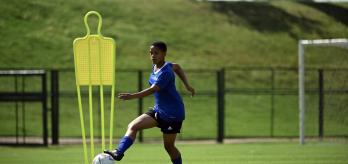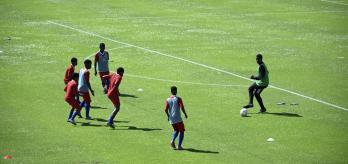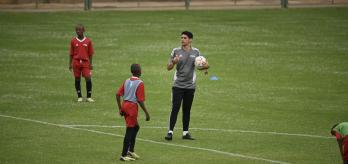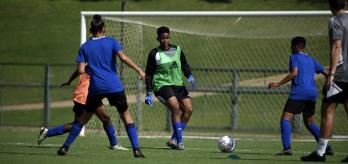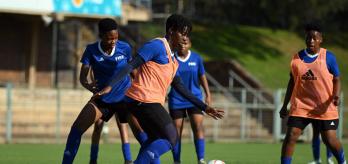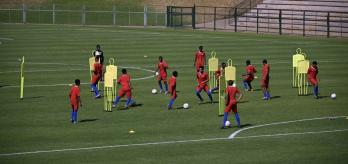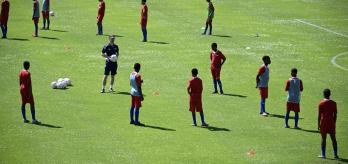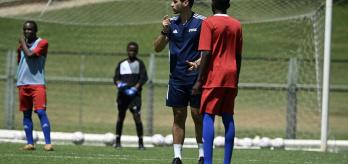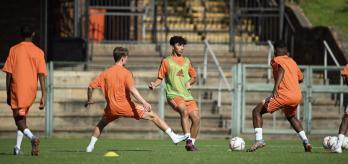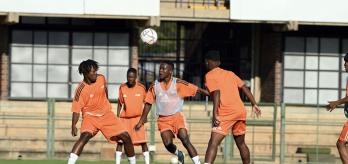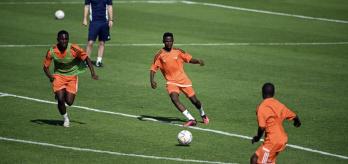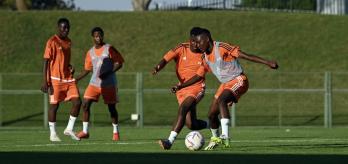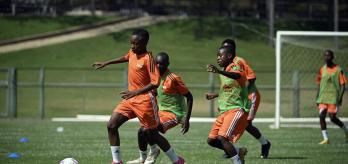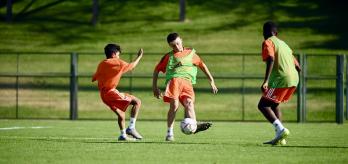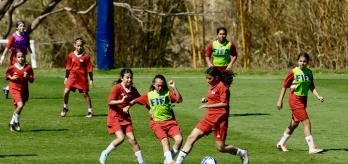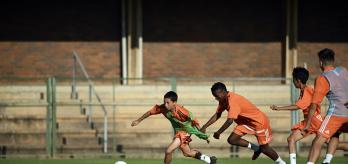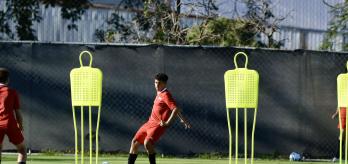Methodology
The intention: What is practised?
This 6v6 plus 3 possession game works on progressing the ball out of crowded areas by using numerical advantages and short combination play. The in-possession team are tasked with creating 3v2 or 4v3 numerical advantages in tight spaces to play around pressing players, and they must recognise the spaces to occupy so as to provide the ball carrier with multiple options. Players are asked to identify when to transfer between zones and help their team-mates to connect play. Players in the end zones should position themselves in space away from defenders at all times to help connecting players find a pass beyond the press.
The scale: For whom is this relevant?
This possession exercise revolves around the unit level and focuses on players finding space in tight areas to progress the ball between the three lines of play. The game is particularly relevant to a unit that is boxed in in a tight space and is trying to play through a relentless press. The set-up simulates the connection between players in the first line, such as centre-backs or defensive midfielders, through central midfielders and into attacking players, who may be positioned outside the opposition’s high press. The exercise is non-position-specific, with all players generally performing the same actions, i.e. those associated with keeping possession and finding space in tight areas.
The practice type: How is the practice designed?
This 6v6 plus 3 game is contested in a reduced playing area that is divided into thirds, which helps to give players a structure in which to progress play. The number of players in each zone is restricted to avoid overcrowding and to ensure that there are three lines through which to progress play at all times. There is a rule in place that allows a member of the in-possession team to move into a neighbouring zone in which their team have the ball. When this scenario arises, the player who move zones is asked to make good use of their time, as they can be joined in the zone by a defender. The goalkeepers provide direction to the play, and the neutral player allows the in-possession team to create numerical advantages and connect play. The reduced size of the playing area requires the players to think quickly and take up intelligent positions.
Session plan
Organisation
-
Mark out a 20m x 10m playing area and split it into three equally sized zones.
-
Divide the players into 2 teams of 6 (oranges and blues) and assign 1 neutral player.
-
Position a goalkeeper at either end of the playing area.
-
Place 2 orange and 2 blue players in each zone.
Explanation
-
The in-possession team try to keep possession and progress the ball from one goalkeeper to the other with the support of the neutral player, who has the freedom to roam between the zones.
-
The defending team try to win the ball.
-
If the defending team gain possession, the teams swap roles immediately.
-
One member of the in-possession team is able to move into a neighbouring zone in which their team have the ball to create a numerical advantage, and they can be joined in the zone by a defender.
Variation
-
Expand the exercise area to 25m x 15m to enable players to put what they learnt into practice and make the game more fluid.
Key coaching points
Roles of coaches
-
First coach: leads the exercise from his position along the side of the central zone, encouraging players to perform it at high intensity. He also feeds balls into the playing area.
-
Second coach: coaches the defenders and attackers from their position along the side of one of the end zones.
- Third coach: coaches from the side opposite the second coach.





















